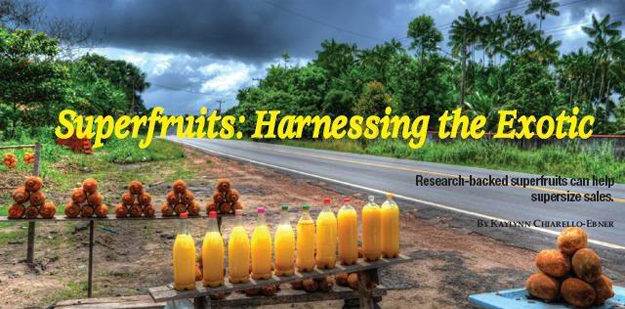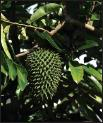If “you are what you eat,” then why not turn to superfruits for super health? Shoppers are asking themselves this question, believing superfruits offer a win–win scenario with delicious taste and feel-great benefits (many of which are data supported).
“People are looking for a tangible health benefit from the products they use, but they still want these products to taste good in regard to foods and beverages or in the case of personal care products, they still need these products to help them feel good about themselves,” says Bob Freeze, vice president of corporate communications for XanGo, LLC, Lehi, UT. “Superfruits help meet this demand.”
Plus, this category satisfies cravings for something out of the ordinary. “Superfruits such as goji berry…offer customers the excitement of trying something new with superior nutritional benefits (supported by scientific evidence), and they are attracted to these fruits for their ‘uniqueness’ of being sourced from a far away ‘exotic’ region of the world,” says Dorie Greenblatt, director of marketing, American Health/Home Health, Ronkonkoma, NY.
So, what exactly are superfruits? According to Carlos Escalante, vice president of Novelle International, Bradenton, FL, “It’s a marketing term, but it is legitimate branding. In general, a superfruit is a fruit that has high nutritional value as compared to the fruits and vegetables consumed by the average family.”
Dean Mosca, president of Proprietary Nutritionals, Inc. (PNI), Kearny, NJ, notes that the term works because it’s memorable. “The prefix of ‘super’ connotes a higher level of intensity or goodness. And, there is truth to it, of the thousands of edible fruits—and vegetables—that offer nutrients to humans, some contain higher levels of antioxidants, carotenoids and other nutraceuticals when compared to others. Although not clearly defined, ‘superfruits’ is a generally acceptable and easy to understand term that means ‘healthier for me,’” he says.
|
NAME THAT FRUIT!
1. The white pulp of this fruit has a sweet flavor, but the outer layers contain xanthones and other phytonutrients. |
Superfruits = Super Benefits
Retailers who want to super-size their superfruit sales should understand the natural allure of the category. Observes Gene Bruno, M.S., M.H.S., consultant for Jarrow Formulas, Inc., Los Angeles, CA, and dean of academics at Huntington College of Health Sciences, “[Fruit is] possibly the only food group that is universally recognized as tasting good as well as being good for us.”
Superfruits are said to offer that little something extra over traditional fruits. “[They] are marketed as having more health benefits than everyday fruit. These days, consumers are looking for affordable ways to preserve their health, because who can afford to get sick?” notes Shaheen Majeed, marketing director of Sabinsa Corporation, Piscataway, NJ.
In fact, studies have linked superfruits to cardiovascular health, mental acuity, joint health and more. Says Margaret Ann Hogan president of Health Support, Inc., Farmingdale, NY, “Eating berries might be a tasty way to protect against heart disease…[They] also have been known to be the secrets of longevity [and] provide year-round antioxidant protection, immune support and mental clarity.”
Skin health, too, shouldn’t be overlooked. Greenblatt notes a trend among personal care formulations to include superfruits because of their “nutrient-rich health benefits.” For example, high-antioxidant goji berries “play a positive role in promoting health benefits for skin, especially in the growing ‘anti-aging’ natural health care category,” she says.
A main reason why superfruits are said to pack such a big nutritional punch across such a wide health spectrum has to do with their natural plant chemicals. In superfruits, such phytochemicals often have strong antioxidant activity, which helps protect our cells against oxidative damage and health conditions associated with such harm.
Says Brant Herman, vice president of operations at Bullwater Health & Fitness/Pomology, Hoboken, NJ, “Superfruits and consumers’ acceptance thereof benefit from their chemical compounds being contained in an attractive natural package.“
Plants can contain a combination of about 20 different phytochemical classifications (many with numerous subcategories), but one familiar face in the superfruit category is flavonoids. This class is said to offer numerous health benefits, and includes chemicals such as resveratrol and rutin. Another familiar class is anthocyanins. Says Bruno, “Usually, the darker the berry, the higher the anthocyanin content.” Certain anthocyanins (like those found in New Zealand blackcurrants), he explains, help “relax the smooth muscle of the eye, which is significant since in near-sightedness that smooth muscle cannot relax enough to allow focusing on distant objects” (1). These anthocyanins may also help with those experiencing eye fatigue and strain (2) and poor night vision (3).
Further examining how phytochemicals come into play with superfruits, Neil E. Levin, CCN, DANLA, nutrition education manager for NOW Foods, Bloomingdale, IL, offers us açaí as an example. He explains that this vitamin C-packed berry is a source of ellagic acid (a phenolic acid), rutin (a flavonoid), anthocyanins and catechins (flavonoids). “These and other antioxidant compounds protect tissues from free radical attack, a key factor in healthy aging. The nutrients and antioxidants in açaí also help support healthy immune and inflammatory response through their modulatory effects on nitric oxide production. Each of these effects is also important for the support of a healthy heart and blood vessels.”
We can also look at the phytochemical breakdown of amla, thanks to information provided by Sabinsa. The company studied this berry to better understand why it has such high antioxidant activity. “We determined that mucic acid gallates and beta-glucogallin are the predominant active molecules in amla, and are significant contributors to amla’s health benefits,” says Majeed. More information about this research is available at www.saberry.net.
To assess antioxidant activity, companies often look at the oxygen radical absorbance capacity (ORAC) value, a score that measures the antioxidant capacity of foods. Many feel that the higher the number, the better the product will neutralize free radicals. But, this number should be used carefully and in context.
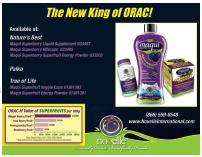 Dan Haggart, president of CHERRish Juices, Bellevue, WA, notes a case in which he found a competitor used an ORAC rating on its product labeling for a raw material—not the actual product in the bottle. “People are buying this product, thinking they’re getting something that’s very antioxidant and they may not be getting anything at all,” he states. “The product had very little antioxidants because they had to dilute it so much to make it taste better. The antioxidants were depleted.”
Dan Haggart, president of CHERRish Juices, Bellevue, WA, notes a case in which he found a competitor used an ORAC rating on its product labeling for a raw material—not the actual product in the bottle. “People are buying this product, thinking they’re getting something that’s very antioxidant and they may not be getting anything at all,” he states. “The product had very little antioxidants because they had to dilute it so much to make it taste better. The antioxidants were depleted.”
While testing can be done, industry doesn’t have a seal of approval for antioxidant activity. But, Brad Miller, co-owner of Stiebs Pomegranate Products, Madera, CA, is developing a system to change this. “I’m forming an Antioxidant Institute and a Web site (www.antioxidant.com) to be able to give certification to products that are actually what they say they are,” Miller envisions. “There are a lot of products out there and no seal of approval.”
He explains that unscrupulous companies can have deceiving, but accurate labels (as Haggart noted). Miller notes, “They may have used other ingredients in there that could fool the test, but really there’s very little açaí in there.”
To address the problem, Miller has a team of scientists who are partnering with the Antioxidant Institute to develop definitions for pass/fail grades for antioxidant activity. And, he hopes to develop a seal for passing products that tells clients that the item has been evaluated by a team of experts and has valid antioxidant activity.
Meanwhile, Haggart and testing firm Brunswick Laboratories have initiated a “Truth in Juice” certification program that determines the antioxidant content in juices based on the ORAC scale. Says Haggart, “If your product isn’t certified for it’s antioxidant content, you can’t be confident as to what you’re actually getting.” CHERRish Juices is encouraging all juice companies to get certified, too.
Formulating Fruits
Superfruits have a great reputation for taste and nutrition, but one area where their image is a bit tarnished is formulation. These testy little buggers have induced many a headache among food and supplement scientists. Says Wes Crain, vice president of Navitas Naturals, Novato, CA, “If it were easy to source and distribute fresh quality superfruits, then everyone would be doing it.” But luckily, industry companies have been creative in taming exotic fruits so that the final product is fresh and efficacious.
|
One huge problem can be product degradation. Açaí, for example, is especially fragile and can lose up to 90% of its nutritional value within 72 hours of harvesting, says Chris Cuvelier, founder and president, Zola Brazilian Superfruits, San Francisco, CA. “Processing the açaí into a pulp and then freezing stops the degradation of nutrients,” he explains, noting that his company’s policy is to move from harvesting to processing within 12 hours “to maximize nutrient retention.”
Also commenting on the importance of using fresh product is Chris D. Meletis, director of science and research for Trace Minerals Research, Ogden, UT, who says, “When super fresh, properly harvested super fruit is collected, transported and processed quickly, degradation is largely controlled.” His company uses proprietary blending techniques to “balance the pH and acidity of each fruit to yield a good-tasting healthy juice.”
Another way to deal with degradation-prone superfruits is to avoid watering down the extract. J. Michael Drabiuk, Pure Fruit Technologies/PFT Brands, Inc., American Fork, UT says his company insists that its ingredients arrive in large, sealed containers with just the concentrate “to protect agriculture in the United States from foreign contaminates, to assure us that we are getting the ripest nutrient-rich fruits for our juices…and to maintain quality raw materials with NO degradation.”
After the concentrate is received, the company won’t add water into its products. Rather, “we utilize the concentrates of other superfruits to broaden the nutritional qualities of our products,” Drabiuk explains. Though the formulation route is more expensive, he believes the final product has a better nutritional profile than if water or preservatives were added.
Because liquid superfruit products can be limiting so companies opt for other routes. According to Levin, his company selects dry extracts and concentrates for some superfruit products. “This gives us more control over stability and potency, creating a comprehensive dietary supplement that is far stronger in antioxidant potency than common fruit juices,” he explains. “Using dry powders in a liquid product actually reduces concerns about molds, fermentation, off-flavors, etc., while allowing far higher potencies as represented by ORAC antioxidant values.”
Adds Richard Passwater, Ph.D., vice president of research and development at Solgar, Inc., Leonia, NJ, “While extracts are not the total fruit, they do offer the advantages of concentrating known beneficial ingredients at a meaningful and controlled level and are encapsulated in softgels so as to preserve their activity and prevent degradation.”
On that note, even tableted or encapsulated formulations can be challenging. Superfruits tend to be hydroscopic, which means they love to absorb and retain water. “The problem is that by the time you add enough excipients [i.e., extra ingredients that help deliver the active ingredient] to compensate for the hydroscopicity and ensure stability, the tablet or capsule may have more excipient than superfruit,” says Bruno. One way to address this issue, he says, is with powdered supplements that can be mixed in a glass of water or juice. He notes that products formulated in this way “avoid problems with hydroscopicity, and any sharp/sour taste issues are easily addressed by allowing consumers to mix the products with their beverage of choice to maximize flavor potential and enjoyment.”
For superfruits that can handle encapsulation, however, Ken Seguine, vice president of sales and marketing, finished products at Avesta, Chatsworth, CA, notes that capsules may also be a good option for pure extracts that don’t pass the consumer taste test. His company’s standardized mangosteen extract is “intensely bitter,” so “encapsulation is the perfect way to deliver the benefits and avoid the unpleasant taste,” he explains.
Reverting back to Levin’s point about dry powders, all superfruit product makers must select packaging carefully to ensure a high-quality product ends up in consumers’ hands. He explains that the firm “uniquely uses oxygen scavenger packets in some 300 of our dry products to prevent oxidation and protect the contents in the bottles.”
Last, many interviewees have raised the point that ensuring a fresh and stable product also is dependant upon which growers/suppliers they choose. Mangosteen, for example, can only be harvested twice a year and isn’t shelf-stable for long periods of time. One mangosteen product specialist (XanGo) has established long-term contracts with “the best suppliers in Southeast Asia” and has the first pick of the crop, says Freeze, who adds, “To ensure top-notch quality of our products, we follow a rigorous process for sourcing and manufacturing from the harvest and puree of the fruit to the end bottling...we can trace each bottle sold to the orchard from which the mangosteen came.”
|
Bill Aims to Ban Certain Pomegranates
Senator Roderick Wright (D-CA) has proposed legislation in California to “stop false advertising by setting clear standards to identify 100% pomegranate juice.” SB 190 Truth in Labeling—Pomegranate Juice offers standards based on a California variety of pomegranate that would, in essence, outlaw other forms of pomegranate grown elsewhere. In fact, the wording is so specific that it excludes nearly everything, but fruit used in Pom Wonderful juice. In contrast, competitors typically source their product from the Middle East, Turkey, India, China and elsewhere. In the past, Pom Wonderful has sued several companies for “mislabeling” pomegranate products that don’t have the specific functional markers of the California variety calling it “adulterated.” Matt Tupper, president of Pom Wonderful, told a California newspaper, “state legislation is necessary because imported pomegranate concentrate is often adulterated with other juices, which could pose a health risk to consumers who buy the juice specifically for its antioxidants.” Others argue that pomegranate from other areas is still pomegranate, and offers a variety in taste, color and price. If the legislation passes, it would essentially create a monopoly for Pom Wonderful and the California pomegranate. An insider commenting on the situation for WholeFoods said this is akin to only allowing the term “apple” to apply to Granny Smiths. Offenders of SB 190 would face fines or jail time. At press time, the bill passed the California State Senate and is moving to the health committee. If passed into law, the bill could have broad-reaching labeling effects. The Natural Products Association West and the Juice Processors Association have spoken out against it. Source: G. Maddaus, “Bill May Squeeze Pom’s Rivals,” The Daily Breeze, June 6, 2009. |
Making a World of Difference
Freeze raises an interesting point. Since many superfruits are grown in specific areas and harvested with precise requirements, several U.S. manufacturers have forged special relationships with suppliers/growers overseas.
On the one hand, as previously noted, companies believe that the closer the ties to the community, the better the final product. Such relationships, Crain believes, “is the only way to ensure a quality product, stable pricing and consistent supply.”
Boosting this sentiment is Cuvelier of Zola, who notes that interest in açaí has led to much growth of the berry on the Brazilian market. But, he says, “not everyone can do it right and more importantly, not all açaí is created equally.” Therefore, he feels strongly in the importance of going straight to the source by aligning with reputable growers to get the “highest quality açaí, the best-tasting açaí and the most consistent supply of açaí. Doing things the right way has helped us secure fruit when others can’t.”
And, Kevin Busby, U.S. general manager of EarthFruits says his company is headquartered in Brazil so that it can directly oversee and supervise the harvesting and production of its superfruit ingredients, which “ensures top-quality fruits directly from the source itself…The EarthFruits team is on the ground, transferring the know-how and carrying out the logistics of the products that will be shipped internationally.” In fact, the company partners with local co-ops to reach fruit deep within “the most pristine parts of the Amazon Rainforest,” which the company feels helps deliver the best-quality product.
These close ties to growers also encourage charitable work in local communities, too. Here’s a smattering of some of these worthy projects:
• Much of the Mapuche Indian community in Southern Chile earns a living by harvesting maqui berry for Novelle International. In February, the firm donated special laptops, software and a projector to Mapuche Indian schoolchildren. The company also sent money to support the community’s New Year Festival.
• After a devastating tsunami hit Thailand in 2004, XanGo paired up with Jarang Fai Dee, a group helping to rebuild villages ineligible for government rebuilding programs. “XanGo executives worked hand-in-hand with Jarang Fai Dee and the local villagers and Buddhist priests to rebuild homes, build the first school, provide uniforms and books for the school, and take care of other needs,” Freeze explains. The community was taught how to make fishing boats to sell for their livelihood.
• 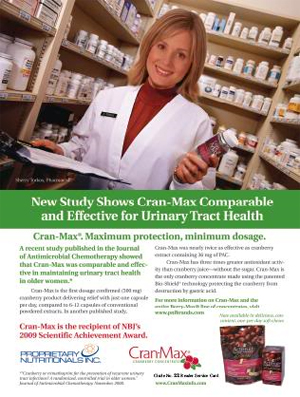 In Thailand, Avesta’s mangosteen extract is made from the dried rinds of fruit that previously were discarded. “Now they supply additional income to farmers and wild gatherers,” says Seguine.
In Thailand, Avesta’s mangosteen extract is made from the dried rinds of fruit that previously were discarded. “Now they supply additional income to farmers and wild gatherers,” says Seguine.
• Navitas Naturals has donated to a Peruvian school located near their growers and provided scholarships to students. “They appreciate our social support and we receive a product made with love that is high quality and super healthy,” says Crain.
• Zola has a multi-tiered project (called Project Zola) that helps a community in Brazil. The project helps eliminate waste from unused açaí seeds, which are typically discarded on the roadsides, where they decompose and create hazardous gas. Instead, Zola encourages the community to make (and sell to Zola) handmade açaí seed bracelets, which are then offered to U.S. retailers for sale. One dollar per bracelet sold goes to Zola’s non-profit foundation that purchases Açaí palms. “Each dollar buys one palm to be planted and serves as a sustainable source of revenue for the local farmers to harvest year over year,” says Cuvelier. And, Zola’s discarded açaí seeds also are donated to a local brickmaker that uses them to fuel its brick-drying oven. “Project Zola has already given back $80,000 to local Brazilian communities and we are excited about reaching our goal of providing $1,000,000 in support by 2012,” Cuvelier notes.
So, retailers should not hesitate to highlight these and other charitable efforts to clients in the form of shelf-talkers about relevant products. Shoppers are often happy to be part of a good cause.
The Next Pomegranate?
Even pomegranate, one of the most popular superfruits, started out as a seedling with modest sales. Those interviewed for this article offer their expectations of which superfruits are poised and ready to explode on the market:
-
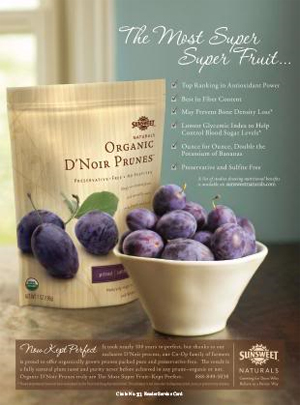 Acerola has a tangy, tart taste and offers high levels of vitamin C.
Acerola has a tangy, tart taste and offers high levels of vitamin C. - Amla (Indian gooseberry) is high in vitamin C “with gallotannins and gallates that amplify and extend the benefits of C in the body to include healthy aging, immunity, digestion, cholesterol and skincare benefits,” says Seguine. Majeed adds that in Ayurvedic tradition, it “is regarded as ‘one of the best rejuvenating herbs.’”
- Baobab, an African superfruit, is said to support immune and digestive health.
- Nutrient-packed caja fruit has a tropical taste.
- Camu-camu may contain more vitamin C than most foods and is rich in potassium, calcium, protein and beta-carotene.
- Cashew fruit is rich in many nutrients and its bark/leaves have anti-inflammatory and astringent properties.
- The Chinese yumberry is said to offer several nutrients including vitamin C, thiamine, riboflavin and carotene.
- Cupuaçu contains high amounts of polyphenol antioxidants.
- Graviola offers many micronutrients and is being studied as a natural cancer and disease fighter, according to Zola.
- New Zealand blackcurrant is a tart–sweet fruit that is abundant in eye health-supporting anthocyanins.
- Murici has been traditionally used for treating respiratory diseases and as a laxative.
- Sea buckthorn berries have over 190 biochemicals and are said to be the only plant source of all omega fatty acids (3, 6, 7 and 9).
- Soursop tastes like a strawberry and pineapple with sour citrus taste. But, its contrasting creamy flavor is similar to a coconut or banana. The fruit offers vitamin C, vitamin B1 and vitamin B2.
- Yacon is a fruit-like vegetable that contains large amounts of the prebiotic, inulin. Yacon has a distinct, sweet flavor and can be made into syrup.
|
Select Superfruit Offerings Avesta offers organic amla in stick packs and mangosteen. |
It should be noted that, like any new ingredients, reputable companies won’t bring new items to market without thoroughly examining its health and market potential. Levin explains what NOW Foods does before bringing something new to market: “It takes NOW Foods several months to move from product concept to finished product. This extensive process ensures that we are careful to assess the sales potential before introducing a new product. It also raises the bar for introducing any product, due to the internal costs involved in this process. NOW has a new products committee that consists of our R&D, marketing and sales managers, myself and two other company nutritionists, a retailer (though several of us have extensive retail experience) and an M.D. We assess the market and the science behind supplier claims. We poll retailers and look at sales reports and competitive products already on the market.”
Retailers, too, should be able to distinguish between a true up-and-coming superfruit staple and one that will be gone tomorrow. Doing so involves evaluating whether it delivers a true and meaningful benefit to the consumers. Says Kirsten Van Sickle, director of marketing at Zola Brazilian Superfruits, “The consumer will see through hype, and a fad will die; if it delivers a meaningful benefit, the consumer may choose to adopt it as part of their daily food and drink repertoire.”
Sometimes, this task means delving into the relevant research on a new superfruit. “There have been a couple of ‘superfruits’ in the past that have been marketed directly to the consumer with claims of being effective for almost everything under the sun. Noni and açaí do have scientific merit as sound antioxidants, but unscrupulous marketers have blown them way out of proportion,” says Mosca of PNI, noting that his company supports retailers trying to separate fact from fiction with new research behind its superfruits.
Adds Noah Herron, marketing coordinator for Verdure Sciences, Noblesville, IN, “Research will help show the history of the fruit, possible health benefits and studies that have been performed. Using this information and predicting the future needs of consumers can help identify possible superfruits that are here to stay.”
Bruno agrees, stressing the point that anecdotal information isn’t enough to support benefits. “It’s fine to say that some superfruit has been used by some indigenous societies for generations, but let’s be fair. We could say the same thing about our consumption of apples or oranges. The real question is what are the benefits of the superfruit beyond providing a source of some basic vitamins and/or minerals?” As previously mentioned, companies evaluating whether to formulate a new superfruit often study the ORAC value as well as any supporting literature that assesses the health value of a particular ingredient. “We suggest that retailers take a similar approach and request literature from their dietary supplement companies that explains what research has been conducted on their superfood products,” says Bruno.
Stores can also participate in educational programs about superfruits, such as those offered by Pomology/ Bullwater Health & Fitness. According to Herman, “The growing body of research will separate certain superfruits from trends that do not have science behind them. Through our trainings and store support, we help retailers convey the research related to the various superfruits optimized in our condition-specific formulations.” WF
References
- H. Matsumoto, et al., “Delphinidin-3-Rutinoside Relaxes the Bovine Ciliary Smooth Muscle through Activation of ETB Receptor and NO/cGMP Pathway,” J. Exp. Eye Res. 80, 313–322 (2005).
- H. Matsumoto, et al., “Stimulatory Effect of Cyanidin 3-Glycosides on the Regeneration of Rhodopsin,” J. Agri. Food Chem.51 (12), 3560–3563 (2003).
- H. Nakaishi, et al., “Effects of Black Currant Anthocyanoside Intake on Dark Adaptation and VDT Work-Induced Transient Refractive Alteration in Healthy Humans,” Alt. Med. Rev. 5 (6), 553–562 (2000).
Published in WholeFoods Magazine, August 2009

